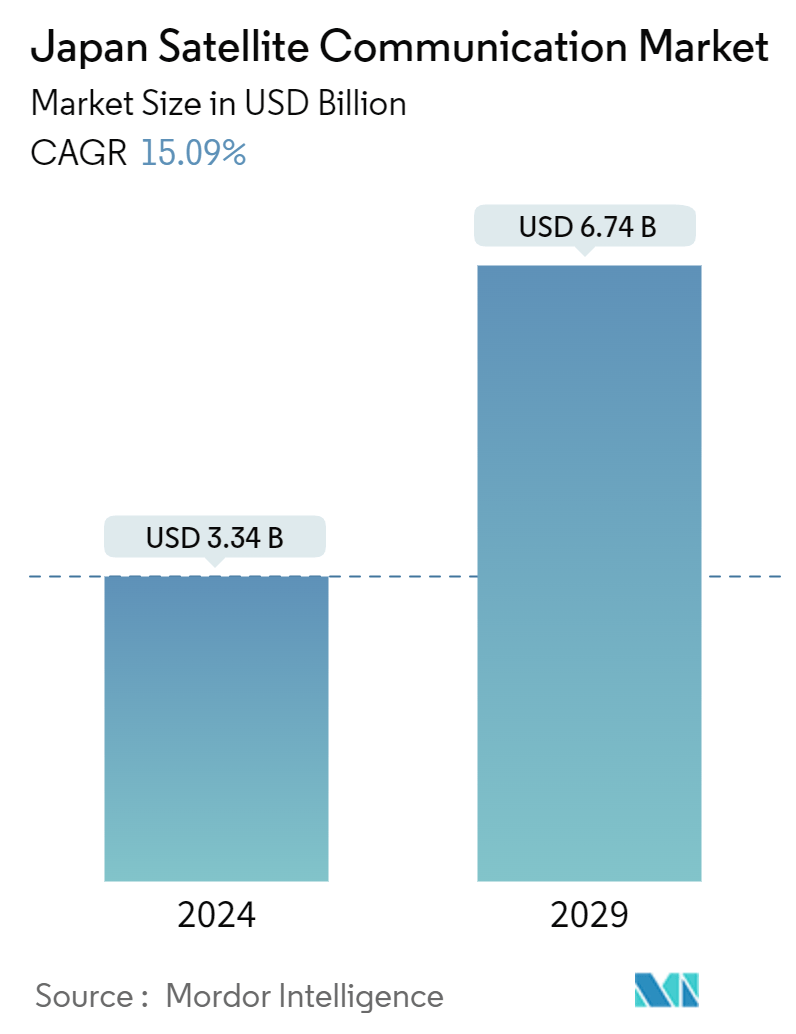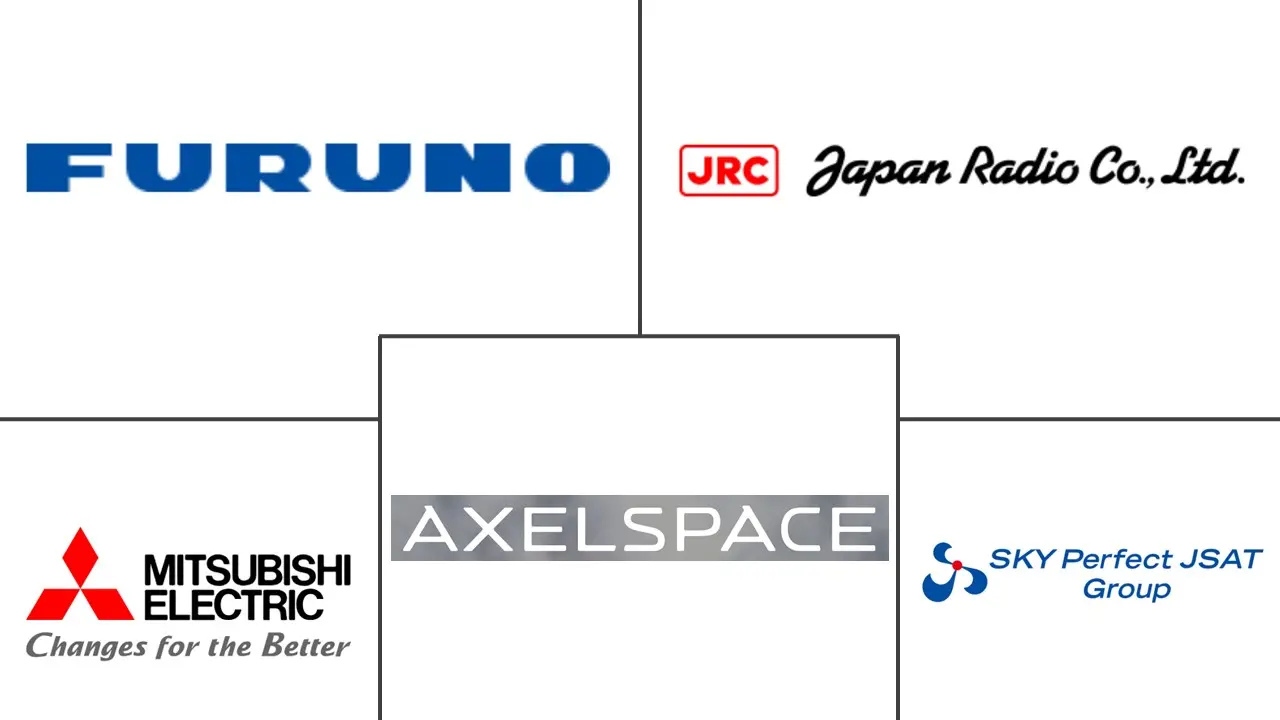Market Size of Japan Satellite Communication Industry

| Study Period | 2019 - 2029 |
| Base Year For Estimation | 2023 |
| Market Size (2024) | USD 3.34 Billion |
| Market Size (2029) | USD 6.74 Billion |
| CAGR (2024 - 2029) | 15.09 % |
| Market Concentration | Medium |
Major Players
*Disclaimer: Major Players sorted in no particular order |
Japan Satellite Communication Market Analysis
The Japan Satellite Communication Market size is estimated at USD 3.34 billion in 2024, and is expected to reach USD 6.74 billion by 2029, growing at a CAGR of 15.09% during the forecast period (2024-2029).
One of the main factors driving the satellite communication industry is Japan's growing requirement for high-speed and consistent broadband connectivity.
- The introduction of 5G technology and technological advancements are one of the primary drivers of the market in Japan. The satellites improve coverage in outlying areas and supplement terrestrial networks. Key competitors are investing in the market through mergers, acquisitions, and other means to grow their presence among customers and better serve their needs across a range of applications.
- For instance, in May 2023, to build local 5G networks employing Dynamic Spectrum Access (DSA) technology on urban expressways in Japan, Sony and Mitsui collaborated on a system feasibility testing study. The businesses claim that this project represents the first effort ever made to use Dynamic Spectrum Access (DSA) technology for local 5G networks to provide automatic coordination of wireless spectrum and prevent damaging radio interference issues. As a result, this project is predicted to significantly contribute to encouraging cooperative usage of local 5G networks in Japan.
- The Japanese government has been actively promoting the satellite communications sector through initiatives and investments. Collaborations and public-private partnerships are also promoting innovation in the industry. Together, these developments help the satellite communication market in Japan expand and advance, enabling better connection, data services, and technical advancements across a range of businesses and sectors. In addition, satellite-based communication systems are used in mobile, automotive, and other applications that require connectivity while in motion. Expanding IoT hardware and software necessitates stable connectivity with a broad reach.
- However, factors like interference in data transmission might be a significant concern that can hamper the overall market's growth throughout the forecast period. Since launching a satellite to send data is a highly sensitive process, cybersecurity has become a significant issue for satellite communication, which can hinder the market's growth.
- Factors like the rising demand for mobile broadband, the growing use of smartphones and smart wearable devices, and the surging demand for mobile video adoption are expected to drive the growth of 5G over the forecast period, which is expected to aid the growth of the market studied. According to the Ministry of Internal Affairs and Communications (Japan), the number of fixed-line broadband service subscriptions in Japan amounted to 44.7 million in 2023, up 0.7 million from the previous year.
Japan Satellite Communication Industry Segmentation
Satellite communication is the transfer of data and information via satellites orbiting the Earth. It enables long-distance communication by relaying signals between ground stations and satellite receivers in orbit, enabling television broadcasts, internet access, and phone calls. The satellite communication (SATCOM) market is defined based on the revenues generated from the types used in various end-user verticals such as maritime, defense and government, enterprises, and media and entertainment. The analysis is based on the market insights captured through secondary research and the primaries. The report also covers the major factors impacting the market's growth in terms of drivers and restraints.
The scope of the study has been segmented based on the type of satellite communication equipment and services (ground equipment (a gateway, very small aperture terminal (VSAT) equipment, network operation center (NOC), and satellite newsgathering (SNG) equipment) and services (mobile satellite services (MSS), fixed satellite services, and earth observation services), platform (portable, land, maritime, and airborne), and end-user vertical (maritime, defense and government, enterprises, media and entertainment, and other end-user verticals). Common satellite communication services include voice calling and internet access for different applications. The report offers market forecasts and size in value (USD) for all the above segments.
The study tracks the key market parameters, underlying growth influencers, and major vendors operating in the industry, supporting the market estimations and growth rates over the forecast period. In addition, the study provides the SATCOM market trends, along with key vendor profiles. The study further analyzes the overall impact of COVID-19 on the ecosystem.
| By Type | |
| Ground Equipment | |
| Services |
| By Platform | |
| Portable | |
| Land | |
| Maritime | |
| Airborne |
| By End-user Vertical | |
| Maritime | |
| Defense and Government | |
| Enterprises | |
| Media and Entertainment | |
| Other End-user Verticals |
Japan Satellite Communication Market Size Summary
The Japan Satellite Communication Market is poised for significant growth, driven by the increasing demand for high-speed and reliable broadband connectivity. The advent of 5G technology and ongoing technological advancements are key factors propelling the market forward. Satellites play a crucial role in enhancing coverage in remote areas and complementing terrestrial networks. Major industry players are actively investing in the market through mergers and acquisitions to expand their customer base and enhance service offerings. The Japanese government's support through initiatives and investments, along with public-private partnerships, is fostering innovation and advancement in the sector. This growth is further supported by the expanding Internet of Things (IoT) ecosystem, which requires stable and extensive connectivity across various applications, including mobile and automotive sectors.
The media and entertainment industry in Japan heavily relies on satellite communication for broadcasting and distributing content globally, which has been instrumental in the sector's expansion. Satellite communication facilitates the delivery of radio and television broadcasts, ensuring widespread access and coverage, even in underserved regions. The development of Direct-to-Home (DTH) services has further extended the reach of media content. The market's expansion is also fueled by the increasing adoption of digital technologies, artificial intelligence, and cybersecurity measures. Prominent ICT companies in Japan contribute significantly to this growth, supported by government investments in infrastructure and modernization projects. Collaborative efforts among major competitors and international partnerships are enhancing Japan's position as a leading ICT hub, with ongoing projects aimed at improving connectivity and standardization in optical and mobile network technologies.
Japan Satellite Communication Market Size - Table of Contents
-
1. MARKET INSIGHTS
-
1.1 Market Overview
-
1.2 Industry Attractiveness - Porter's Five Forces Analysis
-
1.2.1 Bargaining Power of Buyers
-
1.2.2 Bargaining Power of Suppliers
-
1.2.3 Threat of New Entrants
-
1.2.4 Threat of Substitutes
-
1.2.5 Intensity of Competitive Rivalry
-
-
1.3 Industry Value Chain Analysis
-
1.4 Assessment of the Impact of COVID-19 on the Market
-
-
2. MARKET SEGMENTATION
-
2.1 By Type
-
2.1.1 Ground Equipment
-
2.1.2 Services
-
-
2.2 By Platform
-
2.2.1 Portable
-
2.2.2 Land
-
2.2.3 Maritime
-
2.2.4 Airborne
-
-
2.3 By End-user Vertical
-
2.3.1 Maritime
-
2.3.2 Defense and Government
-
2.3.3 Enterprises
-
2.3.4 Media and Entertainment
-
2.3.5 Other End-user Verticals
-
-
Japan Satellite Communication Market Size FAQs
How big is the Japan Satellite Communication Market?
The Japan Satellite Communication Market size is expected to reach USD 3.34 billion in 2024 and grow at a CAGR of 15.09% to reach USD 6.74 billion by 2029.
What is the current Japan Satellite Communication Market size?
In 2024, the Japan Satellite Communication Market size is expected to reach USD 3.34 billion.

